In this blog I´m showing how easy it is to create Web Client using Rest Service in Visual Studio 2017. Here you can find the finish project of the Web Client : https://github.com/elsame/WebClientForRestService and it uses the Rest Service I created in my earlier blog: https://github.com/elsame/RestfulService.
This blog is based on the article https://www.c-sharpcorner.com/article/consuming-asp-net-web-api-rest-service-in-asp-net-mvc-using-http-client/
So you can also fallow that article. The only thing here that is different is that I add the code for all the viewS, not just the employee list view and I´m using my Rest Service that uses Entity Framework and Local Database.
Step 1
Open Visual Studio 2017. Select from Menu File->New->Project in Visual Studio 2017 select ASP.Net Web Application (.Net framework) and call it WebClientForRestService.
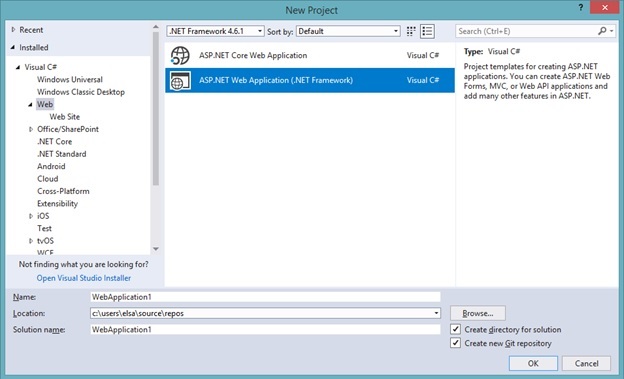
In the next screenshot we select Empty and MVC:
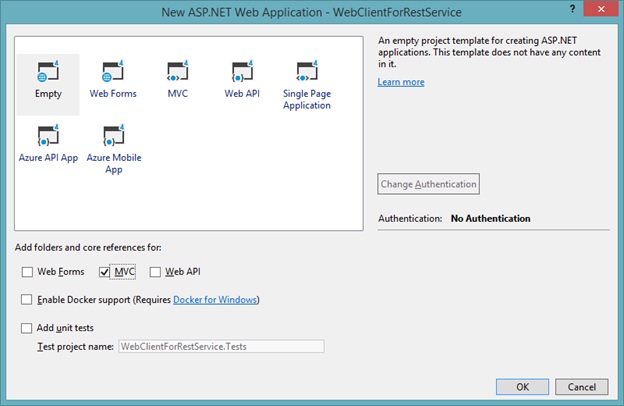
Click “Ok” button and wait.
Step 2
We are going to use HttpClient to consume the Web API REST Service, so we need to install this library from NuGet Package Manager. Right click on the project and select Manage NuGet packages.
HttpClient is base class which is responsible to send HTTP request and receive HTTP response resources i.e from REST services. To install HttpClient, right click on Solution Explorer of created application and search for HttpClient, as shown in the following image.
Browse for system.net.http and install it.
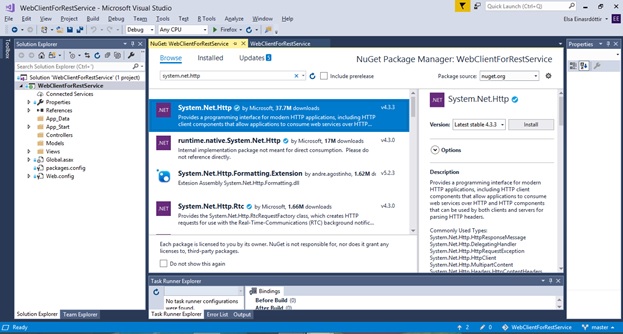
Step 3
Install WebAPI.Client library from NuGet.
This package is used for formatting and content negotiation which provides support for System.Net.Http. To install, right click on Solution Explorer of created application and search for WebAPI.Client, as shown in following image.
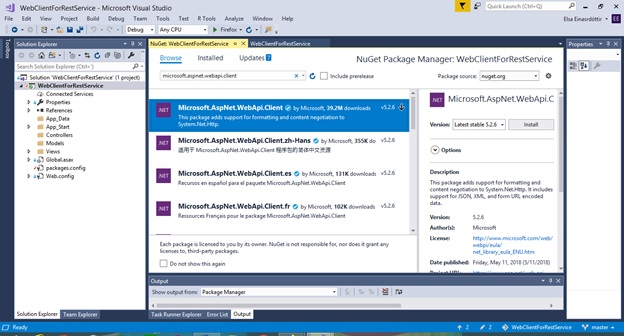
Step 4
Right click on Models map and select Add->class and name it EmployeeModel.cs and add this code to it:
public class EmployeeModel
{
public int Id { get; set; }
public string Name { get; set; }
public string City { get; set; }
}
Step 5
Next I need to create Controller class so I right click on the Controllers folder and select Add->Controller and I choose MVC 5 Controller-Empty.
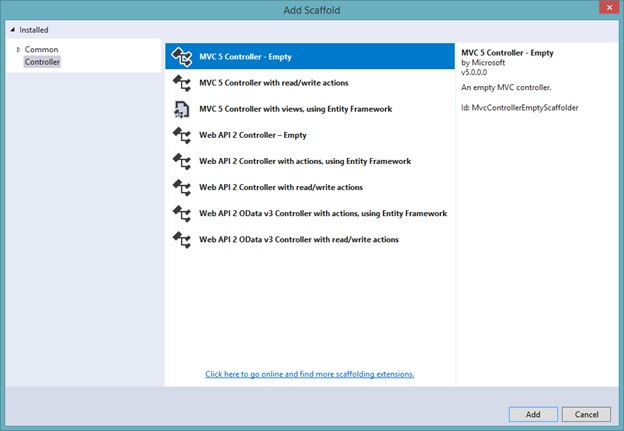
And then click Add. Call it HomeController and wait.
Step 6
Now replace the code inside HomeController with this code:
using System;
using System.Collections.Generic;
using System.Linq;
using System.Web;
using System.Web.Mvc;
using System.Threading.Tasks;
using System.Net.Http;
using RestfulService.Models;
using System.Net.Http.Headers;
using Newtonsoft.Json;
namespace WebClientForRestService.Controllers
{
public class HomeController : Controller
{
// GET: Default
//Hosted web API REST Service base url
string Baseurl = "http://localhost:52651";
private void setClientSettings(HttpClient client)
{
//Passing service base url
client.BaseAddress = new Uri(Baseurl);
client.DefaultRequestHeaders.Clear();
//Define request data format
client.DefaultRequestHeaders.Accept.Add(new MediaTypeWithQualityHeaderValue("application/json"));
}
public async Task<ActionResult> Index()
{
List<EmployeeModel> EmpInfo = new List<EmployeeModel>();
using (var client = new HttpClient())
{
setClientSettings(client);
//Sending request to find web api REST service resource GetAllEmployees using HttpClient
HttpResponseMessage Res = await client.GetAsync("api/EmployeeModels");
//Checking the response is successful or not which is sent using HttpClient
if (Res.IsSuccessStatusCode)
{
//Storing the response details recieved from web api
var EmpResponse = Res.Content.ReadAsStringAsync().Result;
//Deserializing the response recieved from web api and storing into the Employee list
EmpInfo = JsonConvert.DeserializeObject<List<EmployeeModel>>(EmpResponse);
}
//returning the employee list to view
return View(EmpInfo);
}
}
public async Task<ActionResult> Details(int id)
{
EmployeeModel EmpInfo = new EmployeeModel();
using (var client = new HttpClient())
{
setClientSettings(client);
//Sending request to find web api REST service resource GetAllEmployees using HttpClient
HttpResponseMessage Res = await client.GetAsync("api/EmployeeModels/" + id);
//Checking the response is successful or not which is sent using HttpClient
if (Res.IsSuccessStatusCode)
{
//Storing the response details recieved from web api
var EmpResponse = Res.Content.ReadAsStringAsync().Result;
//Deserializing the response recieved from web api and storing into the Employee list
EmpInfo = JsonConvert.DeserializeObject<EmployeeModel>(EmpResponse);
}
//returning the employee list to view
return View(EmpInfo);
}
}
public async Task<ActionResult> Edit(int id)
{
EmployeeModel EmpInfo = new EmployeeModel();
using (var client = new HttpClient())
{
setClientSettings(client);
//Sending request to find web api REST service resource GetAllEmployees using HttpClient
HttpResponseMessage Res = await client.GetAsync("api/EmployeeModels/" + id);
//Checking the response is successful or not which is sent using HttpClient
if (Res.IsSuccessStatusCode)
{
//Storing the response details recieved from web api
var EmpResponse = Res.Content.ReadAsStringAsync().Result;
//Deserializing the response recieved from web api and storing into the Employee list
EmpInfo = JsonConvert.DeserializeObject<EmployeeModel>(EmpResponse);
}
//returning the employee list to view
return View(EmpInfo);
}
}
// POST: EmpModel/Edit/5
[HttpPost]
public async Task<ActionResult> Edit(int id, EmployeeModel empModel)
{
try
{
// TODO: Add update logic here
using (var client = new HttpClient())
{
setClientSettings(client);
//serialize object to Json and create the HttpContent
HttpContent content = new StringContent(JsonConvert.SerializeObject(empModel));
content.Headers.ContentType = new System.Net.Http.Headers.MediaTypeHeaderValue("application/json");
//Sending request to find web api REST service resource GetAllEmployees using HttpClient
HttpResponseMessage Res = await client.PutAsync("api/EmployeeModels/" + id, content);
//Checking the response is successful or not which is sent using HttpClient
if (Res.IsSuccessStatusCode)
{
//Storing the response details recieved from web api
var EmpResponse = Res.Content.ReadAsStringAsync().Result;
}
}
return RedirectToAction("Index");
}
catch
{
return View();
}
}
public async Task<ActionResult> Delete(int id)
{
try
{
// TODO: Add update logic here
using (var client = new HttpClient())
{
setClientSettings(client);
//Sending request to find web api REST service resource GetAllEmployees using HttpClient
HttpResponseMessage Res = await client.DeleteAsync("api/EmployeeModels/" + id);
//Checking the response is successful or not which is sent using HttpClient
if (Res.IsSuccessStatusCode)
{
//Storing the response details recieved from web api
var EmpResponse = Res.Content.ReadAsStringAsync().Result;
}
}
return RedirectToAction("Index");
}
catch
{
return View();
}
}
public ActionResult Create()
{
EmployeeModel emp = new EmployeeModel();
return View(emp);
}
[HttpPost]
public async Task<ActionResult> Create(EmployeeModel empModel)
{
try
{
// TODO: Add update logic here
using (var client = new HttpClient())
{
setClientSettings(client);
//serialize object to Json and create the HttpContent
HttpContent content = new StringContent(JsonConvert.SerializeObject(empModel));
content.Headers.ContentType = new System.Net.Http.Headers.MediaTypeHeaderValue("application/json");
//Sending request to find web api REST service resource GetAllEmployees using HttpClient
HttpResponseMessage Res = await client.PostAsync("api/EmployeeModels/", content);
//Checking the response is successful or not which is sent using HttpClient
if (Res.IsSuccessStatusCode)
{
//Storing the response details recieved from web api
var EmpResponse = Res.Content.ReadAsStringAsync().Result;
}
}
return RedirectToAction("Index");
}
catch
{
return View();
}
}
}
}
Step 7
Now I have to run my RestfulService I created in my last blog:
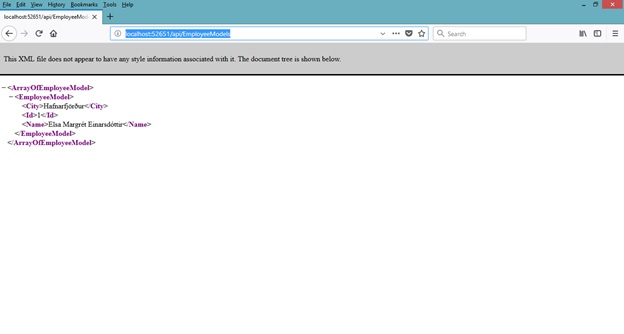
Step 8
Right click on Views folder and select Add->New Folder named Home. Right Click on the Home folder and select Add->view.
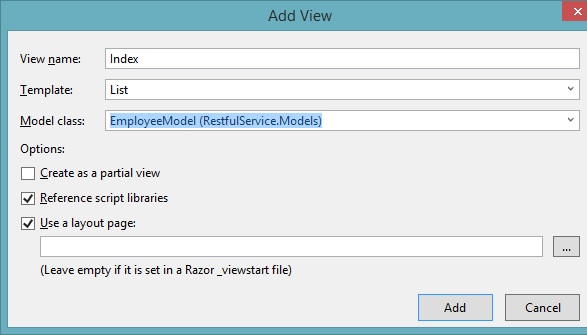
This is our first view, but we are going to add view for each action so we continue this. And select again Add->view a fiew times more:
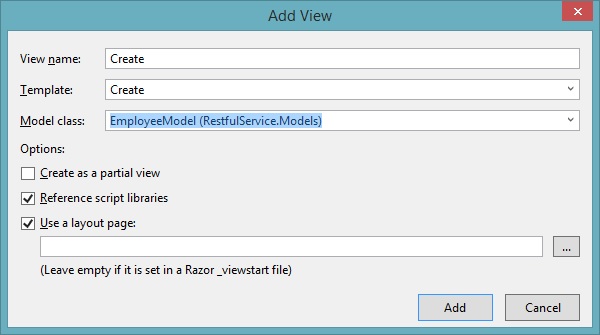
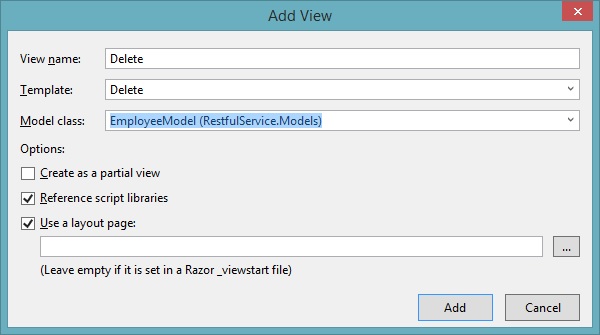
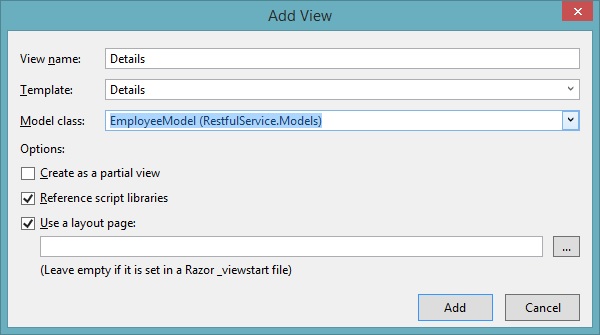
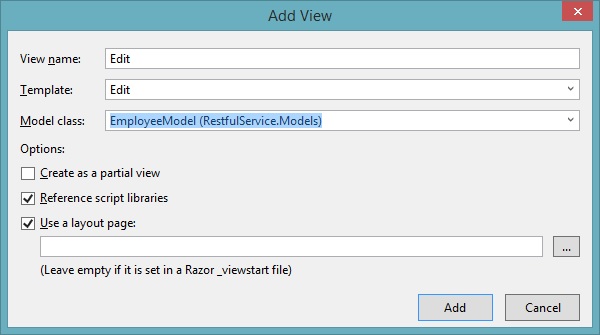
When this is done we compile and run. And it should look like this: (This is the url where my client runs: http://localhost:59320/Home/Index)
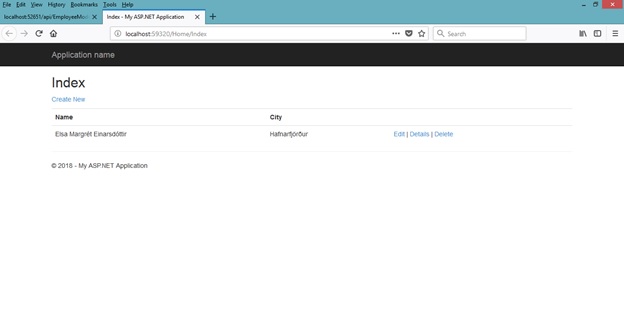
And it should be fully function Web Client where you can get a list of all the employees, create new, edit, see detail and delete employee.
So now we have Rest Service Api that uses Entity Framework to connect to Local Database, can be tested with Swagger and used with this Web Client.